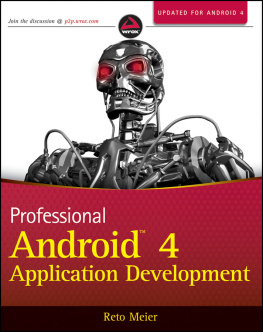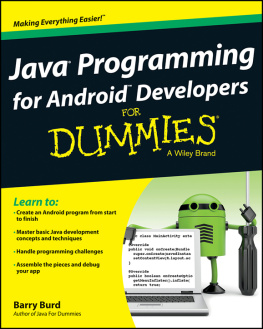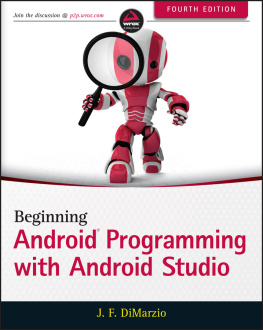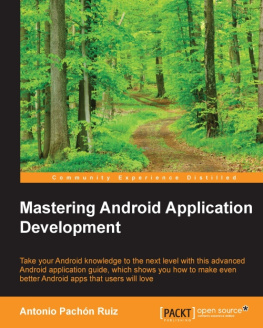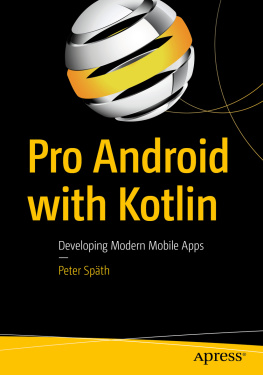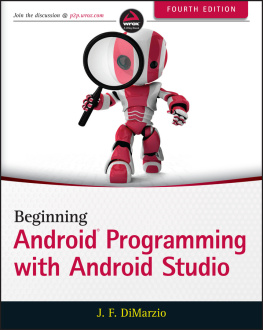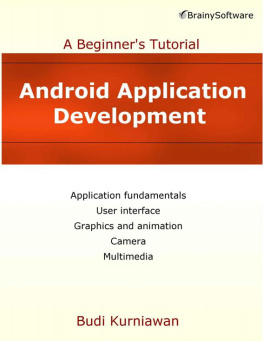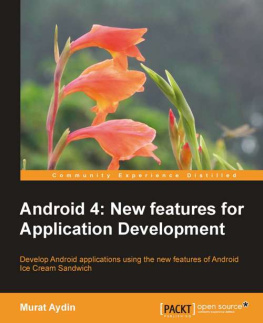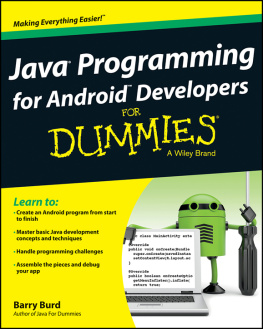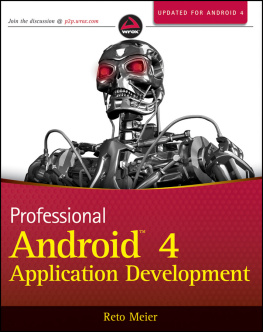Chapter 1
Hello, Android
What's in this Chapter?
A background of mobile application development
What Android is (and what it isn't)
An introduction to the Android SDK features
Which devices Android runs on
Why you should develop for mobile and Android
An introduction to the Android SDK and development framework
Whether you're an experienced mobile engineer, a desktop or web developer, or a complete programming novice, Android represents an exciting new opportunity to write innovative applications for an increasingly wide range of devices.
Despite the name, Android will not help you create an unstoppable army of emotionless robot warriors on a relentless quest to cleanse the earth of the scourge of humanity. Instead, Android is an open-source software stack that includes the operating system, middleware, and key mobile applications, along with a set of API libraries for writing applications that can shape the look, feel, and function of the devices on which they run.
Small, stylish, and versatile, modern mobile devices have become powerful tools that incorporate touchscreens, cameras, media players, Global Positioning System (GPS) receivers, and Near Field Communications (NFC) hardware. As technology has evolved, mobile phones have become about much more than simply making calls. With the introduction of tablets and Google TV, Android has expanded beyond its roots as a mobile phone operating system, providing a consistent platform for application development across an increasingly wide range of hardware.
In Android, native and third-party applications are written with the same APIs and executed on the same run time. These APIs feature hardware access, video recording, location-based services, support for background services, map-based activities, relational databases, inter-application communication, Bluetooth, NFC, and 2D and 3D graphics.
This book describes how to use these APIs to create your own Android applications. In this chapter you'll learn some guidelines for mobile and embedded hardware development, as well as be introduced to some of the platform features available for Android development.
Android has powerful APIs, excellent documentation, a thriving developer community, and no development or distribution costs. As mobile devices continue to increase in popularity, and Android devices expand into exciting new form-factors, you have the opportunity to create innovative applications no matter what your development experience.
A Little Background
In the days before Twitter and Facebook, when Google was still a twinkle in its founders' eyes and dinosaurs roamed the earth, mobile phones were just thatportable phones small enough to fit inside a briefcase, featuring batteries that could last up to several hours. They did, however, offer the freedom to make calls without being physically connected to a landline.
Increasingly small, stylish, and powerful, mobile phones are now ubiquitous and indispensable. Hardware advancements have made mobiles smaller and more efficient while featuring bigger, brighter screens and including an increasing number of hardware peripherals.
After first including cameras and media players, mobiles now feature GPS receivers, accelerometers, NFC hardware, and high-definition touchscreens. These hardware innovations offer fertile ground for software development, but until relatively recently the applications available for mobile phones have lagged behind their hardware counterparts.
The Not-So-Distant Past
Historically, developers, generally coding in low-level C or C++, have needed to understand the specific hardware they were coding for, typically a single device or possibly a range of devices from a single manufacturer. As hardware technology and mobile Internet access has advanced, this closed approach has become outmoded.
Platforms such as Symbian were later created to provide developers with a wider target audience. These systems proved more successful in encouraging mobile developers to provide rich applications that better leveraged the hardware available.
Although these platforms did, and continue to, offer some access to the device hardware, they generally required developers to write complex C/C++ code and make heavy use of proprietary APIs that are notoriously difficult to work with. This difficulty is amplified for applications that must work on different hardware implementations and those that make use of a particular hardware feature, such as GPS.
In more recent years, the biggest advance in mobile phone development was the introduction of Java-hosted MIDlets. MIDlets are executed on a Java virtual machine (JVM), a process that abstracts the underlying hardware and lets developers create applications that run on the wide variety of devices that support the Java run time. Unfortunately, this convenience comes at the price of restricted access to the device hardware.
In mobile development, it was long considered normal for third-party applications to receive different hardware access and execution rights from those given to native applications written by the phone manufacturers, with MIDlets often receiving few of either.
The introduction of Java MIDlets expanded developers' audiences, but the lack of low-level hardware access and sandboxed execution meant that most mobile applications were regular desktop programs or websites designed to render on a smaller screen, and didn't take advantage of the inherent mobility of the handheld platform.
Living in the Future
Android sits alongside a new wave of modern mobile operating systems designed to support application development on increasingly powerful mobile hardware. Platforms like Microsoft's Windows Phone and the Apple iPhone also provide a richer, simplified development environment for mobile applications; however, unlike Android, they're built on proprietary operating systems. In some cases they prioritize native applications over those created by third parties, restrict communication among applications and native phone data, and restrict or control the distribution of third-party applications to their platforms.
Android offers new possibilities for mobile applications by offering an open development environment built on an open-source Linux kernel. Hardware access is available to all applications through a series of API libraries, and application interaction, while carefully controlled, is fully supported.
In Android, all applications have equal standing. Third-party and native Android applications are written with the same APIs and are executed on the same run time. Users can remove and replace any native application with a third-party developer's alternative; indeed, even the dialer and home screens can be replaced.
What Android Isn't
As a disruptive addition to a mature field, it's not hard to see why there has been some confusion about what exactly Android is. Android is not the following:
- A Java ME implementationAndroid applications are written using the Java language, but they are not run within a Java ME (Mobile Edition) VM, and Java-compiled classes and executables will not run natively in Android.
- Part of the Linux Phone Standards Forum (LiPS) or the Open Mobile Alliance (OMA)Android runs on an open-source Linux kernel, but, while their goals are similar, Android's complete software stack approach goes further than the focus of these standards-defining organizations.
- Simply an application layer (such as UIQ or S60)Although Android does include an application layer, Android also describes the entire software stack, encompassing the underlying operating system, the API libraries, and the applications themselves.

